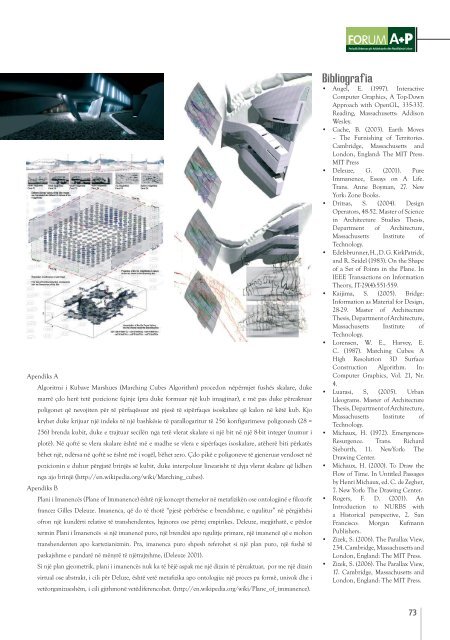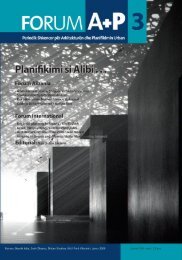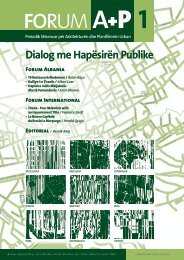Forum A+P 02
POLIS University publishes the “Forum A+P” journal, the only scientific and cultural magazine in the Albanian –speaking countries for the fields of architecture and territory planning. This magazine is recognized by the Ministry of Education and Science, the Academic Degrees Evaluation Committee and has an ISSN international registration code in France. The magazine is published in Albanian and English language and contains a package of scientific, informative articles and analysis.
POLIS University publishes the “Forum A+P” journal, the only scientific and cultural magazine in the Albanian –speaking countries for the fields of architecture and territory planning. This magazine is recognized by the Ministry of Education and Science, the Academic Degrees Evaluation Committee and has an ISSN international registration code in France. The magazine is published in Albanian and English language and contains a package of scientific, informative articles and analysis.
Create successful ePaper yourself
Turn your PDF publications into a flip-book with our unique Google optimized e-Paper software.
Apendiks A<br />
Algoritmi i Kubave Marshues (Marching Cubes Algorithm) procedon nëpërmjet fushës skalare, duke<br />
marrë çdo herë tetë pozicione fqinje (pra duke formuar një kub imagjinar), e më pas duke përcaktuar<br />
poligonet që nevojiten për të përfaqësuar atë pjesë të sipërfaqes isoskalare që kalon në këtë kub. Kjo<br />
kryhet duke krijuar një indeks të një bashkësie të parallogaritur të 256 konfigurimeve poligonesh (28 =<br />
256) brenda kubit, duke e trajtuar secilën nga tetë vlerat skalare si një bit në një 8-bit integer (numur i<br />
plotë). Në qoftë se vlera skalare është më e madhe se vlera e sipërfaqes isoskalare, atëherë biti përkatës<br />
bëhet një, ndërsa në qoftë se është më i vogël, bëhet zero. Çdo pikë e poligoneve të gjeneruar vendoset në<br />
pozicionin e duhur përgjatë brinjës së kubit, duke interpoluar linearisht të dyja vlerat skalare që lidhen<br />
nga ajo brinjë (http://en.wikipedia.org/wiki/Marching_cubes).<br />
Apendiks B<br />
Plani i Imanencës (Plane of Immanence) është një koncept themelor në metafizikën ose ontologjinë e filozofit<br />
francez Gilles Deleuze. Imanenca, që do të thotë “pjesë përbërëse e brendshme, e ngulitur” në përgjithësi<br />
ofron një kundërti relative të transhendentes, hyjnores ose përtej empirikes. Deleuze, megjithatë, e përdor<br />
termin Plani i Imanencës si një imanencë puro, një brendësi apo ngulitje primare, një imanencë që e mohon<br />
transhendenten apo kartezianizmin. Pra, imanenca puro shpesh referohet si një plan puro, një fushë të<br />
paskajshme e pandarë në mënyrë të njëtrajtshme, (Deleuze 2001).<br />
Si një plan gjeometrik, plani i imanencës nuk ka të bëjë aspak me një dizain të përcaktuar, por me një dizain<br />
virtual ose abstrakt, i cili për Deluze, është vetë metafizika apo ontologjia: një proces pa formë, univok dhe i<br />
vetëorganizueshëm, i cili gjithmonë vetëdiferencohet. (http://en.wikipedia.org/wiki/Plane_of_immanence).<br />
Bibliografia<br />
• Angel, E. (1997). Interactive<br />
Computer Graphics, A Top-Down<br />
Approach with OpenGL, 335-337.<br />
Reading, Massachusetts: Addison<br />
Wesley.<br />
• Cache, B. (2003). Earth Moves<br />
– The Furnishing of Territories.<br />
Cambridge, Massachusetts and<br />
London, England: The MIT Press.<br />
MIT Press<br />
• Deleuze, G. (2001). Pure<br />
Immanence, Essays on A Life.<br />
Trans. Anne Boyman, 27. New<br />
York: Zone Books.<br />
• Dritsas, S. (2004). Design<br />
Operators, 48-52. Master of Science<br />
in Architecture Studies Thesis,<br />
Department of Architecture,<br />
Massachusetts Institute of<br />
Technology.<br />
• Edelsbrunner, H., D. G. KirkPatrick,<br />
and R. Seidel (1983). On the Shape<br />
of a Set of Points in the Plane. In<br />
IEEE Transactions on Information<br />
Theory, IT-29(4):551-559.<br />
• Kaijima, S. (2005). Bridge:<br />
Information as Material for Design,<br />
28-29. Master of Architecture<br />
Thesis, Department of Architecture,<br />
Massachusetts Institute of<br />
Technology.<br />
• Lorensen, W. E., Harvey, E.<br />
C. (1987). Marching Cubes: A<br />
High Resolution 3D Surface<br />
Construction Algorithm. In:<br />
Computer Graphics, Vol. 21, Nr.<br />
4.<br />
• Luarasi, S, (2005). Urban<br />
Ideograms. Master of Architecture<br />
Thesis, Department of Architecture,<br />
Massachusetts Institute of<br />
Technology.<br />
• Michaux, H. (1972). Emergences-<br />
Resurgence. Trans. Richard<br />
Sieburth, 11. NewYork: The<br />
Drawing Center.<br />
• Michaux, H. (2000). To Draw the<br />
Flow of Time. In Untitled Passages<br />
by Henri Michaux, ed. C. de Zegher,<br />
7. New York: The Drawing Center.<br />
• Rogers, F. D. (2001). An<br />
Introduction to NURBS with<br />
a Historical perspective, 2. San<br />
Francisco: Morgan Kufmann<br />
Publishers.<br />
• Zizek, S. (2006). The Parallax View,<br />
234. Cambridge, Massachusetts and<br />
London, England: The MIT Press.<br />
• Zizek, S. (2006). The Parallax View,<br />
17. Cambridge, Massachusetts and<br />
London, England: The MIT Press.<br />
73





